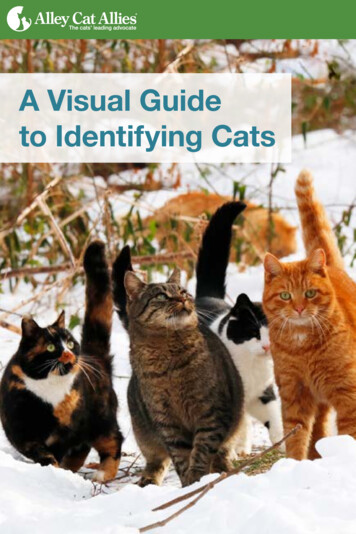
Transcription
A Visual Guideto Identifying Cats
When cats have similar colors and patterns, like two gray tabbies, it canseem impossible to tell them apart! That is, until you take note of eventhe smallest details in their appearance.Knowledge is power, whether you’re an animal control officer or animalshelter employee who needs to identify cats regularly, or you want toidentify your own cat. This guide covers cats’ traits from their overall looks,like coat pattern, to their tiniest features, like whisker color.Coat LengthLet’s use our office cats as examples: Oliver (left): neutered male, shorthair,solid black, pale green eyes, blackwhiskers, a black nose, and blackpaw pads. Charles (right): neutered male,shorthair, brown mackerel tabby withspots toward his rear, yellow-greeneyes, white whiskers with some blackat the roots, a pink-brown nose, andblack paw pads.As you go through this guide, remember that certain patterns and markingsoriginated with specific breeds. However, these traits now appear in manycats because of random mating.HairlessHairless cats have no fur.ShorthairShorthair cats have short fur acrossthe entire body.This guide covers the following features:Medium hairCoat Length .3Medium hair cats have longer furaround the mane, tail, and/or rear.Coat Color.4Coat Patterns.6Markings.8Feature Colors.10Unique Identifiers.12Determining Sex .13Additional Resources.152 2018 Alley Cat Allies. All rights reserved.LonghairLonghair cats have long, fluffy fur.A VISUAL GUIDE TO IDENTIFYING CATS3
Coat ColorsBelow you’ll find the most common base coat colors. Coats maybe solid color or a combination of colors. Tortoiseshell and calico,while technically coat patterns, are only seen in the specific colors.BlackBlack is one of the most commoncolors. Many black cats havegolden eyes.GrayGray is a diluted black. It is oftenseen under tabby stripes.4 2018 Alley Cat Allies. All rights reserved.BuffBuff, or tan, is a diluted orange,often accompanied by dark orangetabby stripes.BrownSolid brown cats are very rare andusually only seen in specific breeds.Brown is more commonly seenalong with tabby stripes.OrangeOrange, also known as red, isanother very common color.About 80 percent of orange catsare male.TortoiseshellTortoiseshell (tortie) is a mixed blendof orange and black, or a dilutedversion with gray and buff. Tortiesare almost always female.WhiteCalicoPure white cats exist, but the mostcommon way to see white on a catis in a bicolor pattern—patches ofwhite with another color.Calico is distinct patches of solidorange, black, and white, or a dilutedversion with buff, gray, and white.They are almost always female.A VISUAL GUIDE TO IDENTIFYING CATS5
Coat PatternsFour types oftabby patternsPatterns can appear in many colors, and cats can have multiplepatterns. For example, a cat can be orange and white bicolorwith tabby stripes (as seen below left).ClassicWide stripes ina marbled,circular patternMackerelBicolorPointed Also calledpiebald Light-coloredbody Always white andanother color Darker color onears, face, tail,and legs Can have a lot ofwhite or very littleShaded Fur is white atbase andgets darkertoward tips Typically seen inlonghair catsTabby M-shape patternon forehead Typically striped,but there arefour types Can appear in anycolor or patternThin verticalstripes downfrom the back,with a darkstripe the lengthof the backTickedNo body stripes(individual hairshave bands ofcolor) and thinstripes on face,legs, and tailSpottedRound spotsinstead of stripes6 2018 Alley Cat Allies. All rights reserved.7
MarkingsMarkings are an important factor in identifying cats. They canpresent themselves in different colors and patterns, and non-whitemarkings can also have patterns. Cats can have several markingsat once. These are just a few common markings.LocketBlazeWhite stripe between the eyesEye patchColored spot across one eye, on amostly white faceTriangularwhite patchon the chestTuxedoTypically black and white, with a blazeup the nose and a “jacket” on the backTail TipDifferent color,usually white,on the tip ofthe tailSnowshoeSocksPointed pattern with blue eyes andwhite markings on the face and bodyDifferent color,usually white,on paw or legVanDid You Know?Kittens can be born with tabby markings that disappearover time, or be born a solid color and develop markings.8 2018 Alley Cat Allies. All rights reserved.All-white body with colored markingson the head and tail onlyA VISUAL GUIDE TO IDENTIFYING CATS9
Feature ColorsEye ColorTypically cats have green,yellow, or blue eyes in avariety of shades.All kittens are born withblue eyes, but their truecolor develops between6 and 8 weeks old.A dichroic eye (notpictured) has patches ofdifferent colors.Odd-eye cats havedifferent colored eyes.The color of cats’ eyes, paw pads, whiskers, andnoses can help in their identification.WhiskersWhiskers are typically black, white, or acombination. Even individual whiskers canhave both colors.NosesNoses are typically black, pink, gray, brown,tan, or a spotted combination of these colors.Paw padsPaw pads are typically black, pink, mauve,or a spotted combination of these colors.Each paw pad can be a different color.Did You Know?The wild ancestor of the domestic cat species had tabbystripes. Through breeding, a variety of different patterns andmarkings developed over time.10 2018 Alley Cat Allies. All rights reserved.A VISUAL GUIDE TO IDENTIFYING CATS11
Unique IdentifiersEartipThe universal sign that a community cathas been spayed or neutered.Learn more at alleycat.org/Eartip.Ear NotchAn alternative to the eartip, but notrecommended by Alley Cat Allies.Folded EarsDetermining SexIt can be difficult to determine if cats are male or female.The easiest and quickest way to tell is by looking at the spacebetween the anus and the genital opening.Less than½ inchFemaleFemales have less than ½ inch between the anusand the genital opening. If she is spayed, you maysee a surgery scar on her stomach, but you can’talways tell without a veterinarian’s help.More than1 inchNeutered MaleThe tips of the ears are folded over, oftendue to genetics.Neutered males have more than 1 inch betweenthe anus and the genital opening. Althoughneutered males no longer have testicles, somecats still have the extra skin and fur in that area.PolydactylAlso called Hemingway cats, these felineshave an extra toe, or toes, on one ormore paws.ManxA missing or partial tail, due to geneticsor previous injury.12 2018 Alley Cat Allies. All rights reserved.More than1 inchIntact MaleIntact males have more than 1 inch between theanus and the genital opening, and have testicles.They also have broader heads and jawlines.A VISUAL GUIDE TO IDENTIFYING CATS13
Additional Resources:Learn more about identifying cats to increase their chances ofreturning to their owners at alleycat.org/IDGuide.Record your own cat’s colors, markings, andmore with our helpful worksheet. That way,you’ll be able to accurately describe yourcat’s appearance if needed.Download for free at alleycat.org/IDGuide.But my cat doesn’t look like any of these cats!All cats are unique and can have a variety of colors, patterns, andmarkings. This guide covers the basics of cat identification, but no guidecan capture all the distinct characteristics, variations, and combinationsof features.Get an at-a-glance version of this guidewith our “Cat Coat Colors, Patterns, andLengths” poster. Hang it up in your shelter orveterinary clinic for quick reference, and tomake identifying cats easier. You can find itin our shop at alleycat.org/Shop.It’s helpful to consider other distinct features: Does she have any unique markings, like an orange tail tip ora spot shaped like a heart? Does she have old injuries that stand out, like a missing eye ora patch of missing hair? Does she have all her teeth? Is she declawed? If so, on which paws?Note: Alley Cat Allies is against the cruel and unnecessary practiceof declawing cats. However, if a cat has been declawed, it can helpidentify her.14 2018 Alley Cat Allies. All rights reserved.Microchips play a critical role in reuniting catswith their families. Owners should ensure theircats are microchipped, and animal shelter staffand veterinarians should plan to scan every catwho comes into their facility for a microchip.Not only does it get cats back home, it alsosaves lives.Learn more about the importance of microchipping and ourPlan to Scan campaign at alleycat.org/PlanToScan.A VISUAL GUIDE TO IDENTIFYING CATS15
Connect with us AlleyCatAllies7920 Norfolk Avenue, Suite 600, Bethesda, MD 20814-2525 www.alleycat.org 2018 Alley Cat Allies. All rights reserved.
12 2018 Alley Cat Allies.All rights reserved. A VISUAL GUIDE TO IDENTIFYING CATS 13 Folded Ears The tips of t










